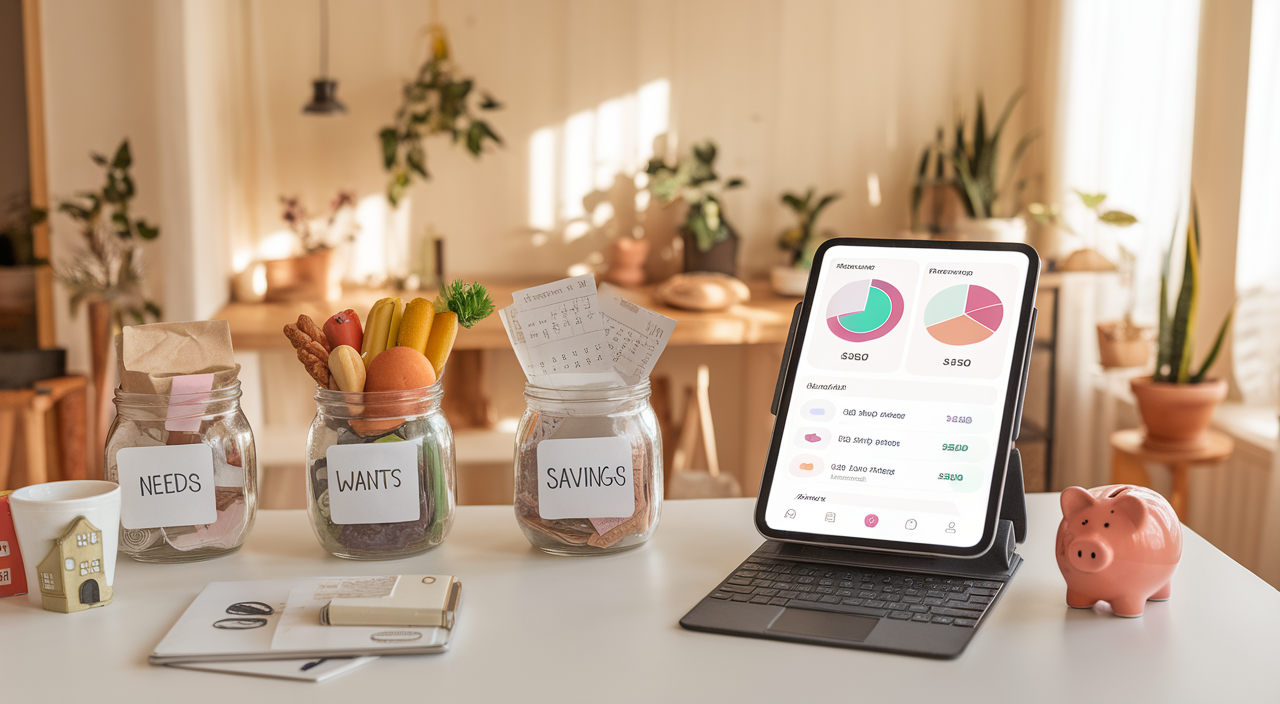The secret to budgeting without feeling deprived lies in the 50/30/20 rule, creating a perfect balance between financial responsibility and personal enjoyment. This approach recognizes that spending on wants isn’t optional but essential, allocating 30% of your income for guilt-free pleasure while still meeting needs and saving for the future.
Key Takeaways
- The 50/30/20 rule divides your after-tax income into 50% for essentials, 30% for wants, and 20% for savings and debt repayment.
- Setting up automatic transfers on payday helps make this system work effortlessly by allocating money to separate accounts for needs, wants, and savings.
- Value-based spending focuses on directing money toward purchases that provide genuine satisfaction and align with your personal values.
- Including a 3–5% financial buffer in your monthly budget prevents stress when unexpected expenses arise.
- Using budgeting apps with visual tools can transform financial management from a tedious task into an empowering daily habit.
I’ve found this approach frees you from the constant guilt many budget systems create. Instead of cutting out everything you enjoy, the 50/30/20 rule builds pleasure into your financial plan. The key is setting clear boundaries between categories and honoring them.
After implementing automatic transfers, I noticed my financial stress dropped significantly. My money moved to the right accounts before I could spend it, and I always knew exactly how much I could spend on fun without derailing my goals.
This simple system works for both beginners and experienced budgeters. It adapts to changing incomes and priorities while maintaining the core principle: balance between responsibility and enjoyment creates sustainable financial habits.
Why the 50/30/20 Rule is Your Path to Guilt-Free Spending
The secret to budgeting without feeling deprived isn’t about strict limitations – it’s about smart allocation. I’ve found that the 50/30/20 rule creates the perfect balance between responsibility and enjoyment, making it easier to stick to your financial goals while still living life to the fullest.
Breaking Down the 50/30/20 Rule for Maximum Freedom
Just like planning your meals can simplify daily decisions, the 50/30/20 rule streamlines your spending choices. Here’s how to divide your after-tax income:
- 50% goes to essential needs (housing, utilities, groceries, basic transportation)
- 30% is reserved for wants (dining out, entertainment, shopping)
- 20% is dedicated to savings and debt repayment
This approach gives you permission to enjoy life while building financial security. Instead of getting stuck in decision paralysis about every purchase, you’ll have clear boundaries that actually create freedom.
The Secret to Budgeting Without Feeling Deprived: Mindful Allocation
By setting aside 30% for wants, this method acknowledges that enjoying life isn’t optional – it’s essential. Just as creating pleasant morning routines sets you up for success, allocating funds for enjoyment prevents financial burnout.
I’ve noticed that when people try to restrict all non-essential spending, they often end up overspending from frustration. The 50/30/20 rule prevents this by building guilt-free pleasure into your budget. Plus, knowing that you’re simultaneously saving 20% helps eliminate that nagging feeling that you should be doing more with your money.
This system also helps prevent overwhelming yourself with too many financial goals. Instead of tracking every penny, you can focus on these three simple categories. The secret to budgeting without feeling deprived lies in this balance – you’re meeting your needs, planning for your future, and still having fun along the way.
Remember, these percentages aren’t set in stone. They’re guidelines that you can adjust based on your income level and living situation. The key is maintaining the principle of balanced allocation that includes both responsibility and enjoyment.
Turn Your Paycheck Into a Perfect Plan: A Real Example
The Secret to Budgeting Without Feeling Deprived: Breaking Down Your Income
Let me show you how to transform your monthly paycheck into a practical budget that won’t leave you feeling restricted. Picture this: You’ve got $3,500 in take-home pay each month. Instead of getting overwhelmed by complex financial choices, I’ll break this down into manageable chunks using the 50/30/20 rule.
Your essential needs get the biggest slice at 50% ($1,750), covering rent, utilities, groceries, and basic transportation. The fun part? You still get $1,050 (30%) for wants – that’s your entertainment, dining out, and those cozy coffee shop visits. The remaining $700 (20%) goes straight to your future self through savings or debt payments.
Smart Automation: The Secret to Budgeting Without Feeling Deprived
I’ve found that setting up automatic transfers on payday is key to making this system work effortlessly. Think of it as giving your money a job before you’re tempted to spend it. Here’s what I suggest doing right after getting paid:
- Create three separate accounts for needs, wants, and savings
- Set up automatic transfers to move money into each account immediately
- Add a 5% buffer ($175) to your needs category for unexpected price increases
- Schedule bill payments to align with your payday
As your income grows, stick to these percentages while avoiding lifestyle inflation. The beauty of this system is its flexibility – you can adjust the numbers while maintaining the core structure. For an extra layer of organization, try planning your monthly expenses visually to track your progress and stay motivated.
Remember, the secret to budgeting without feeling deprived isn’t about restriction – it’s about creating a sustainable plan that grows with you while protecting your financial future.
Smart Spending That Sparks Joy
The Secret to Budgeting Without Feeling Deprived is Value-Based Spending
I’ve discovered that the secret to budgeting without feeling deprived starts with a simple mindset shift — focusing on joy instead of restrictions. Just like making smart choices without stress, budgeting becomes easier when you connect it to your personal values.
By tracking where your money goes and rating each purchase on a satisfaction scale, you’ll quickly spot patterns in your spending habits. This isn’t about cutting everything out — it’s about making intentional choices that bring genuine happiness. Think of it as creating a personal comfort zone with your finances.
Creating Your Joy-Driven Budget
The secret to budgeting without feeling deprived lies in identifying your true sources of fulfillment. I recommend these steps to maximize satisfaction while managing your money:
- Rate recent purchases on a 1–10 satisfaction scale
- Track how long the satisfaction from each purchase lasts
- Note which expenses align with your core values
- Identify spending that feels hollow or regrettable
Once you’ve mapped out your joy-generating expenses, you can plan your spending thoughtfully, just like meal prepping for the week. This approach helps avoid the overwhelming feeling of restriction that often comes with traditional budgeting.
By channeling your money into experiences and items that provide lasting satisfaction, you’ll naturally spend less on things that don’t matter to you. I’ve found that the secret to budgeting without feeling deprived becomes clear when you realize it’s not about cutting back — it’s about redirecting resources to what truly enriches your life.
This value-based approach transforms budgeting from a restrictive practice into an empowering tool. Instead of feeling limited, you’ll feel more in control and satisfied with your spending choices, knowing each dollar serves your well-being and happiness.
Your Financial Safety Net: Building in Buffers
The Secret to Budgeting Without Feeling Deprived: Smart Buffer Planning
Building a financial buffer into your budget isn’t just smart – it’s essential for maintaining peace of mind. I recommend setting aside 3-5% of your monthly income as a safety net, which helps prevent the stress of making rushed financial decisions when unexpected costs arise.
The secret to budgeting without feeling deprived lies in careful tracking and regular adjustments. By monitoring your spending patterns, you’ll spot areas where you can create cushions without sacrificing life’s pleasures. I’ve found that avoiding financial overwhelm comes from having clear spending categories and reviewing them weekly.
Creating Flexible Financial Cushions
Your buffer strategy should include these key components:
- Daily expense tracking across all spending categories
- Weekly budget reviews to spot potential overruns
- Monthly adjustments based on changing needs
- Quarterly assessment of buffer adequacy
The secret to budgeting without feeling deprived also involves smart meal planning – I’ve discovered that preparing attractive, cost-effective meals can help maintain your buffer while enjoying good food. Starting each day right with mindful morning routines can set you up for better financial decisions.
By maintaining flexibility in your budget and building these protective cushions, you’re creating a sustainable approach to managing your money. This strategy isn’t about restriction – it’s about making room for both necessities and enjoyment while protecting your financial future. The secret to budgeting without feeling deprived becomes clear when you see these buffers as empowering tools rather than limiting factors.
Tech Tools and Tricks for Effortless Budgeting
Smart Apps That Make The Secret to Budgeting Without Feeling Deprived Reality
I’ve found that the right tech tools can transform budgeting from a tedious task into an empowering daily habit. Just like planning your meals ahead saves money, using budgeting apps helps you visualize and control your spending without feeling restricted.
The secret to budgeting without feeling deprived starts with automating your financial tracking. Modern budgeting apps can categorize your expenses instantly, giving you real-time insights into your spending patterns. This automatic categorization helps you spot areas where you’re overspending while highlighting categories where you’ve got extra wiggle room.
Automation and Visual Tools for Financial Success
Similar to how avoiding productivity burnout requires smart systems, the secret to budgeting without feeling deprived relies on setting up automatic transfers. I recommend scheduling automatic savings deposits right after payday – this ensures you’re building wealth without thinking about it.
Here are the essential tech features I use to maintain financial clarity:
- Real-time spending notifications to stay aware of daily expenses
- Custom spending limits with friendly alerts
- Visual graphs showing monthly spending trends
- Automatic bill payment scheduling
- Goal tracking with progress indicators
To boost your financial knowledge while managing money, I’ve discovered that avoiding decision fatigue is crucial. That’s why I suggest dedicating just 15 minutes each morning to review your finances – perhaps during your peaceful morning routine.
Visual representations of your spending can make a huge difference in understanding your financial habits. Charts and graphs help identify patterns you might miss in standard bank statements, making it easier to adjust your budget without feeling restricted.
One way to stay on top of your money without sacrificing fun is by learning how to budget wisely and plan for occasional splurges.
Sources:
Investopedia: How Should You Be Budgeting in 2025?
Congressional Budget Office: The Budget and Economic Outlook: 2025 to 2035
White House: Budget of the United States Government, Fiscal Year 2025
Congressional Budget Office: The Long-Term Budget Outlook: 2025 to 2055
Indeed: What Is the 50-20-30 Budget Rule? Uses, Benefits & Examples
European Commission: Budget Support Guidelines
Investopedia: The 50/30/20 Budget Rule Explained With Examples
Mary Guffey: Essentials of Business Communication










